Sendinblue Email Marketing Review And Comparison
If email marketing is an essential component of your online business – as it should – then you might be in search of top-of-the-line email marketing software. In this Sendinblue review, I will show you what you can expect from this email marketing service and help you decide if it is the right choice for you. I will also compare Sendinblue with our own email marketing app - AVADA Email Marketing.
What follows is an in-depth analysis of what Sendinblue offers, its best features, its pricing plans, how it stands up to the competition, and which type of business should get it. I speak from experience as AVADA has been in the email marketing industry for a couple of years.
Let’s first take a look at what Sendinblue is.
What is Sendinblue?
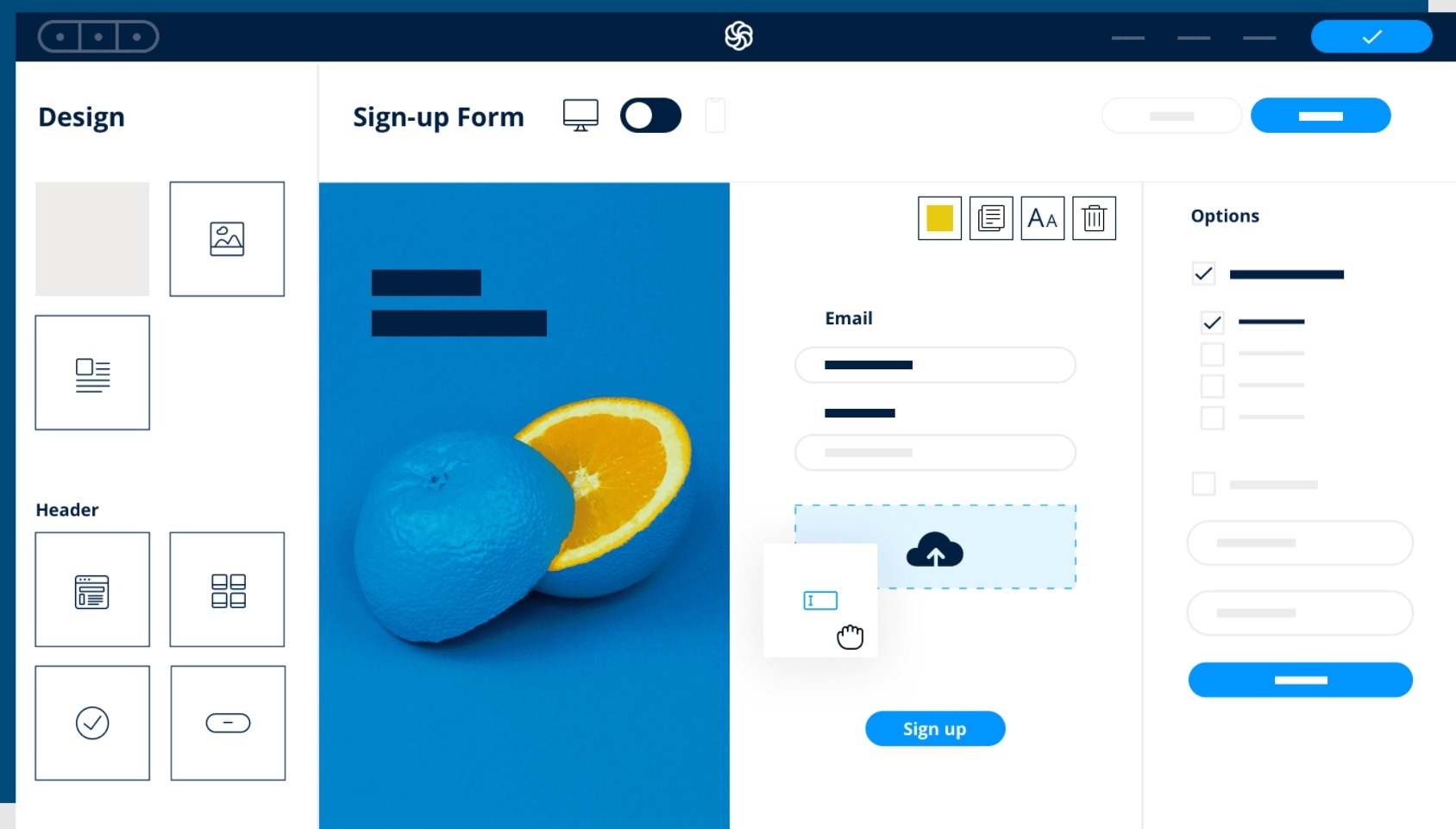
Sendinblue advertises itself as an all-in-one email marketing service that can solve one of the biggest challenges for small to medium-sized businesses: automating email marketing at a little cost.
Since first starting as a digital marketing agency, Sendinblue has gained more popularity, quickly being one of the most well-known email marketing platforms available nowadays. They initially created the platform to meet SMEs’ needs, which many digital marketing platforms had poorly served.
Now, Sendinblue is a popular and reputable digital marketing platform, offering a rich feature set and competitive pricing plans. With more than 175,000 users in 160 countries and sending more than 100 million emails every day, Sendinblue sure has come a long way in 10 years of experience.
In the next section, let’s see Sendinblue’s key features to see why they could become an important platform of the modern digital marketing landscape.
7 Sendinblue’s key features review
Sendinblue has earned its reputation for providing a top-quality platform and many efficient tools. But, there is a reason that you hear their name time and time again. The features of Sendinblue should cover all the basic things you’d want to do with email marketing right off the bat.
What you can expect from Sendinblue is a decent email template editor, contact management and sorting, email automation, social media integration, landing page builder, and even SMS marketing. I will go into more detail now.
1. Email templates and customization

The main question for anyone using an email marketing service is: how will my emails actually look? Can the app make emails that fit your brand and style guide or show your personality? The answers to those questions for Sendinblue are “not bad” and “probably yes.” However, it is not a soundly “yes,” and I will explain that right now.
Basically, in Sendinblue, you can choose from one of three ways to build an email campaign:
-
The drag-and-drop editor – A common feature of email marketing software - which allows you to put images, text, buttons, etc, into a simple email visual layout, and you can see what the reader sees.
-
The rich text editor – Imagine writing a real mail in words, but a lot simpler. This is better for companies that use text-heavy newsletters, but you can still add images and buttons into this.
-
Custom code – You can create your own HTML email template, or hire one to make for you, then import it to Sendinblue. This option of editing provides the most creative control, but is at the same time the most complicated way to build emails.
Going back to the drag-and-drop editor of Sendinblue (which is the tool most people will probably use), there are 60+ templates users can start with, or you can design an email from scratch if you want to. Sendinblue templates are a mix of modern and minimal designs, with some being a bit more colorful and dynamic than others. They’re sorted into categories like Sale, Holiday Greeting, Newsletter, and more.
All of the Sendinblue templates are responsive and mobile-friendly, so your smartphone users/customers are covered. Given that we have more smartphones in circulation than desktops or laptops these days, that’s an essential feature. Another important feature, the templates support many other languages such as Arabic, Hebrew, and Kurdish.
However, there are no stock photos. To be precise, there isn’t a library of stock photos that you can choose from. There are some default images available in the templates, but users are definitely supposed to replace those by using their own images.
The email editor of Sendinblue itself is fairly simple, having an easy-to-understand interface. You can drag and drop in content in different email layouts, create image galleries, and add columns to the emails. The functionality of the editor is limited to what you can actually show in an email, and, to be honest, there’s not much to display. The drag-and-drop editor of Sendinblue basically does exactly what it’s supposed to, only with a few bells or whistles.
2. Email personalization
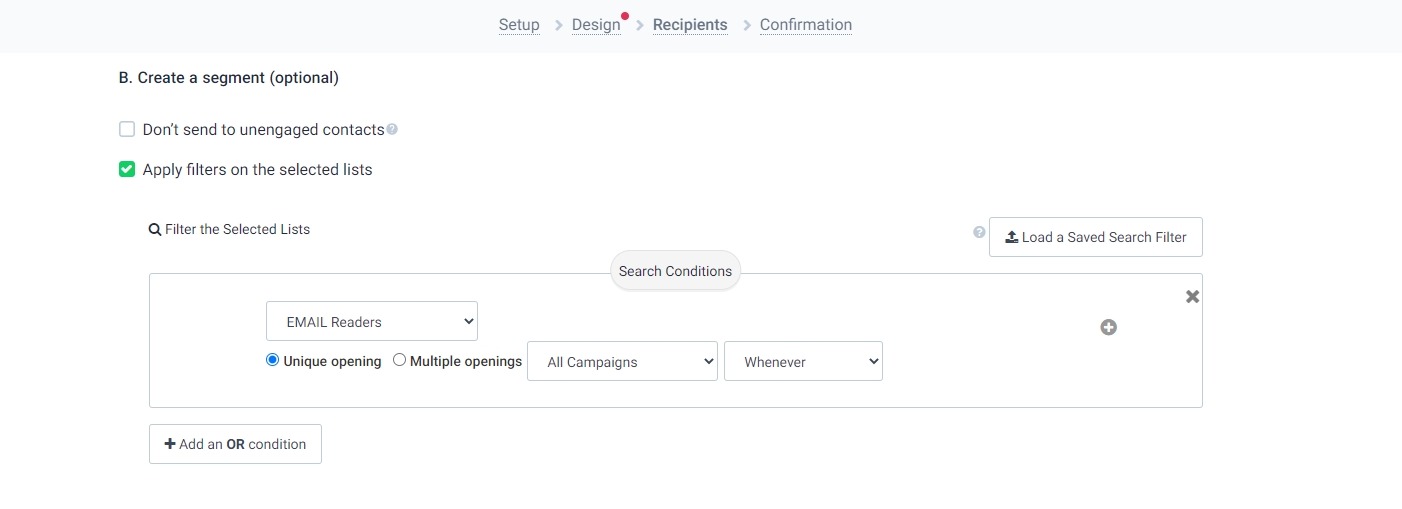
Where Sendinblue gets (sort of) fancy is the personalization and conditional display feature. Now what are those?
Personalization is an essential part of email marketing platforms nowadays. Basically, you can put personalizable elements into the content like your subscribers’ first or last names. That’s how businesses send thousands of emails, and everyone can see their actual name appearing in the content. So instead of “Dear Customer whose name we don’t know,” users can get, “Hey Janet! Here are some deals just for you!”
The conditional display feature is a similar concept. So let’s say your customers are in New York, and some in Bangkok, Thailand, because it is that way sometimes. If you sort your contacts by location (and that’s something you can do inside the app with just a bit of work), you can insert content into your email campaigns that actually change based on the reader’s location. So your New York customers can see New York deals, and Bangkok customers can see deals tailored to them as well.
You can also change the email content based on other factors in Sendinblue, such as how long it’s been since your recipients have clicked through to your website or opened your marketing emails. This feature is limited to how detailed your emailing list is, though. The more information you can get, the better the result for email personalization.
Users can also create two different versions of every email campaign to see what kind of content, subject lines, and email layouts work better for them. This is called A/B testing in email marketing, and it basically allows users to send two different versions of your email campaign simultaneously. Thus, some recipients in the mailing list will see “version A” while the others will see “version B.”
3. List management

Personalization can’t work without data, so how you can manage and segment your email list means a lot to the success of your email marketing campaigns.
Personalization can’t work without data, so how you can manage and segment your email list means a lot to the success of your email marketing campaigns.
Importing contacts in Sendinblue is simple enough, thankfully. Users can import all standard file formats for contacts, such as xls(x) files, csv files, and comma-separated text files. If you have an existing mail software or a bunch of addresses in a spreadsheet, you can import your email list of addresses in one of those formats.
Naturally, the file you choose can include your contacts’ names, phone numbers, physical addresses, the date of signing up, and any other details you need, all stored in a table-style database. Sendinblue can import them all and include all information as sortable, searchable data. Of course, you can also copy and paste the data straight from any Microsoft Excel file, and Sendinblue will do the same data-transfering magic.
To grow your list, you can create a web form and put it on any page of your eCommerce website to collect email addresses. The classic newsletter sign-up form that you can create in the form of a pop-up. All collected addresses can be added to a specific mailing list or even put into a blocklist.
This is incredibly useful to manage unsubscribes. However, keep in mind that many countries have laws that you need to have a way for recipients to unsubscribe from your emails. Speaking of which, importing email addresses requires you to have consent from everyone on the list, or you can have a possible chance of being banned or even legally sued.
Once you have imported your contacts, you can sort and mage them as you run your email campaigns. There are four main aspects to managing email lists with Sendinblue, which are:
-
Listing options
-
List hygiene
-
Segmentation
-
List suppression or blacklists
For listing options, Sendinblue lets you sort and list the email addresses you’ve collected by name, subscription date, SMS number, IP address, and more. You can include whatever information you give, but if you import addresses without attaching IP addresses, you won’t be able to search with IP. Basically, Sendinblue infers little in your list information, but can be a bit inconvenient if you only upload raw email addresses.
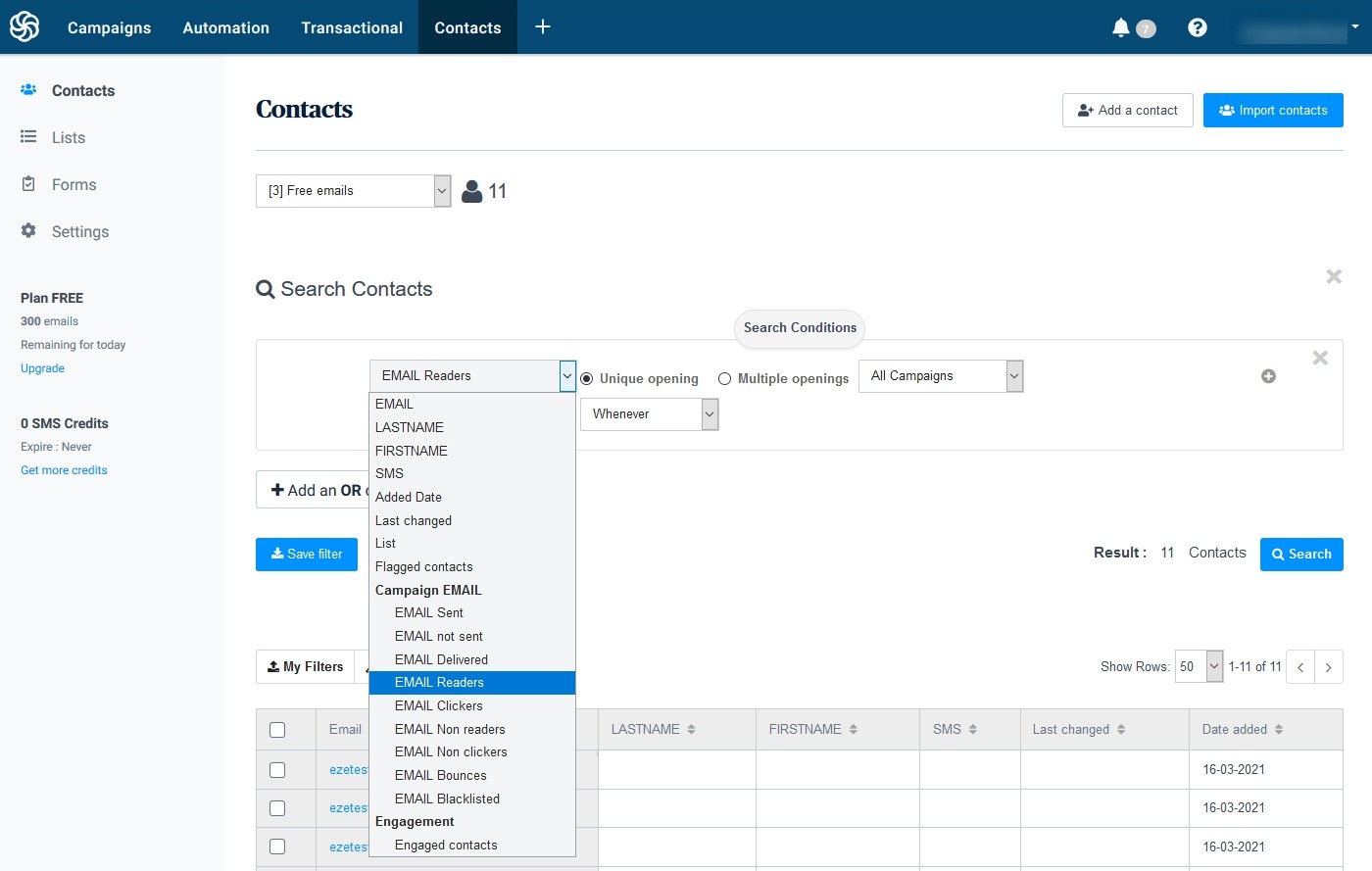
For segmentation, you can sort your contacts by more advanced criteria, or more precisely, how subscribers have interacted with the emails that you’ve sent out or your eCommerce website. You can set up a filter for contacts who have opened your emails and clicked through the links in them.
Sendinblue manages list segmentation through its advanced search feature. Once you’ve done a specific search with many rules (e.g. “look for contacts that have opened my emails”), you can save your search parameters as a filter.
Once you’ve received filtered search results, you can always select the resulting contacts and make a new list. That list can automatically update based on your search criteria, and you should check the box that is “Dynamic list.” Then, there’s always an up-to-date list of people who have opened your emails.
For list hygiene, you can locate users that have engaged with your email campaigns, and who have possibly clicked through, then sort them from users who just don’t seem interested in your offers. In Sendinblue, this feature is the search/filter mentioned above.
Use this feature to make sure that your email list is full of people who are worth your efforts and will respond well to your emails, because many recipients won’t have the same kind of engagement.
For list suppression, you want to include contacts that you do not want to send emails to, at least for a period of time, or not for a specific campaign. You can select these contacts manually or search for them with segmentation and filters, but you can create “exclusion lists” with Sendinblue.
To permanently remove or blacklist any contact, you can have people unsubscribe on their own, for starters. Then, you can block individual email addresses manually or even upload whole lists of contacts to prevent sending emails to. For example, you can avoid sending emails to a list of people who unsubscribed from your list from the previous campaign.
Lastly, you can also blacklist an entire domain, if you wish to. This is useful if you want to make sure that no campaign goes to anyone on your own email servers. Or, maybe, you want to avoid any domain owner that doesn’t want your emails.
4. Landing pages
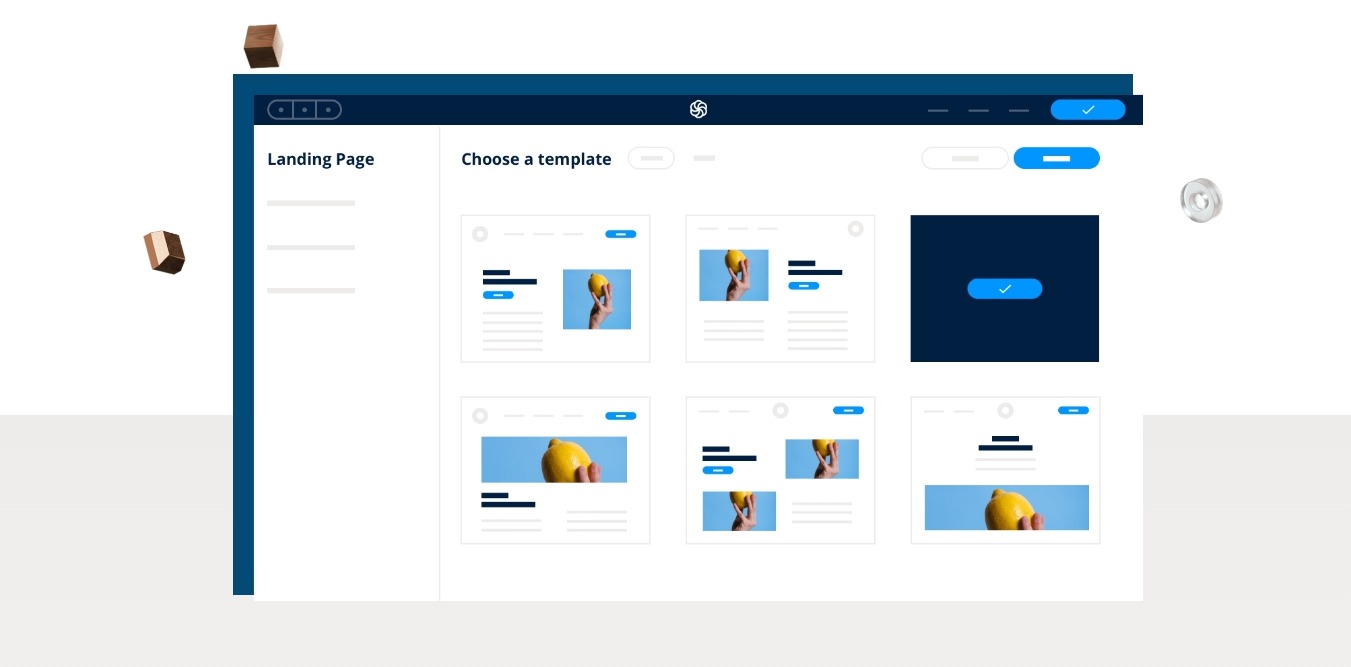
Sendinblue also has a landing page builder, which can be fantastic for advertising specific products or services (and one-off deals).Now, full disclosure: I didn’t get to test this feature properly because it’s locked behind a quite expensive Premium plan. That said, here’s what I can determine:
The templates of the landing pages are similar to the email templates: they are minimal, mobile-friendly, and you have a good few of them to choose from. From the examples of Sendinblue landing pages I’ve been able to find, they look quite good.
You can, of course, build your landing pages from semi-scratch if you want to, using blocks of content and predefined layouts in a drag-and-drop editor. You can also build more than one landing page, and chain these together to create an onboarding experience or post-sign-up process for the user. And yes, these landing pages can be used to get people to sign up to your emails.
These landing pages can also be connected to a domain name that you’ve already bought, which means they’ll appear to be a part of your website. On the Premium plan of Sendinblue, you can create from 5 to 20 landing pages (depending on how much you pay), and more than 20 landing pages on the Enterprise plan.
5. Email automation
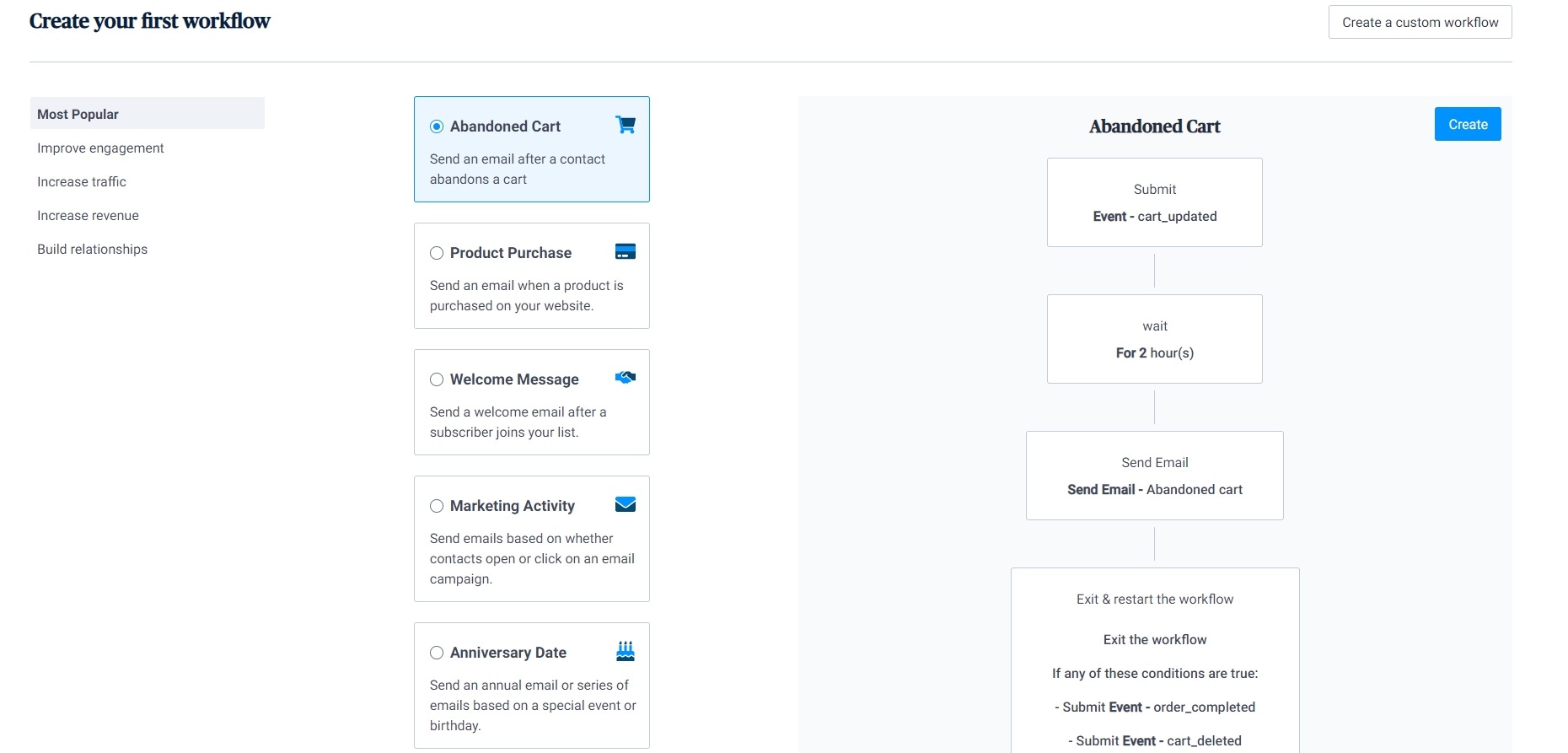
And now, the most important part: the automation features. There are many cool things you can do with email automation that takes the stress out of setting up emails to and following up on thousands of people.
For example: You have an online shoe store and 500 people signed up to your weekly newsletters of shoe maintenance advice, and you want to give discounts for buyers at different times throughout the year. You don’t start sending promotional emails right away, because your readers may get annoyed. Instead, you send a little notice about discounts in the weekly newsletter with a link to learn more.
This link takes them to a landing page - which tells them more about the exclusive discounts for subscribers. If they sign up, their addresses get copied over to a new mailing list, and you can automatically send them a confirmation email that says: “Yes, now you are set to see the latest deals”. Just like that, you have a marketing automation workflow for discounts that you can set and forget.
The automation tool of Sendinblue is simple enough to use. You just need to assemble the series of events as you want the sequence to happen in a diagram. Multiple points of entry can be inside a single workflow (e.g. you can have subscribers come to your landing pages via several different emails and an SMS campaign), in order to direct many users through the same process.
Sendinblue automation tool comes with three templates to start using, including:
-
Abandoned cart automation - Useful for making potential customers come back and finish purchasing their cart. Or at least, you can make them look around your eCommerce store some more.
-
Welcome message automation – This does what it says. When a person signs up to your mailing list, they automatically receive a welcome message to thank them for signing up (and maybe send a little discount to get them started).
-
Anniversary automation - Has a subscriber had a birthday recently? Use this automation workflow to send an automated email and congratulate them. Just don’t say their actual age in the message.
These workflows can also change contact attributes. For example, they can update a contact’s email address, email, buying status, and other information you can think of. You can also take advantage of these workflows and mark a buyer as interested in a specific product, for example. Then, you can send more emails promoting that specific product.
6. Analytics and reporting
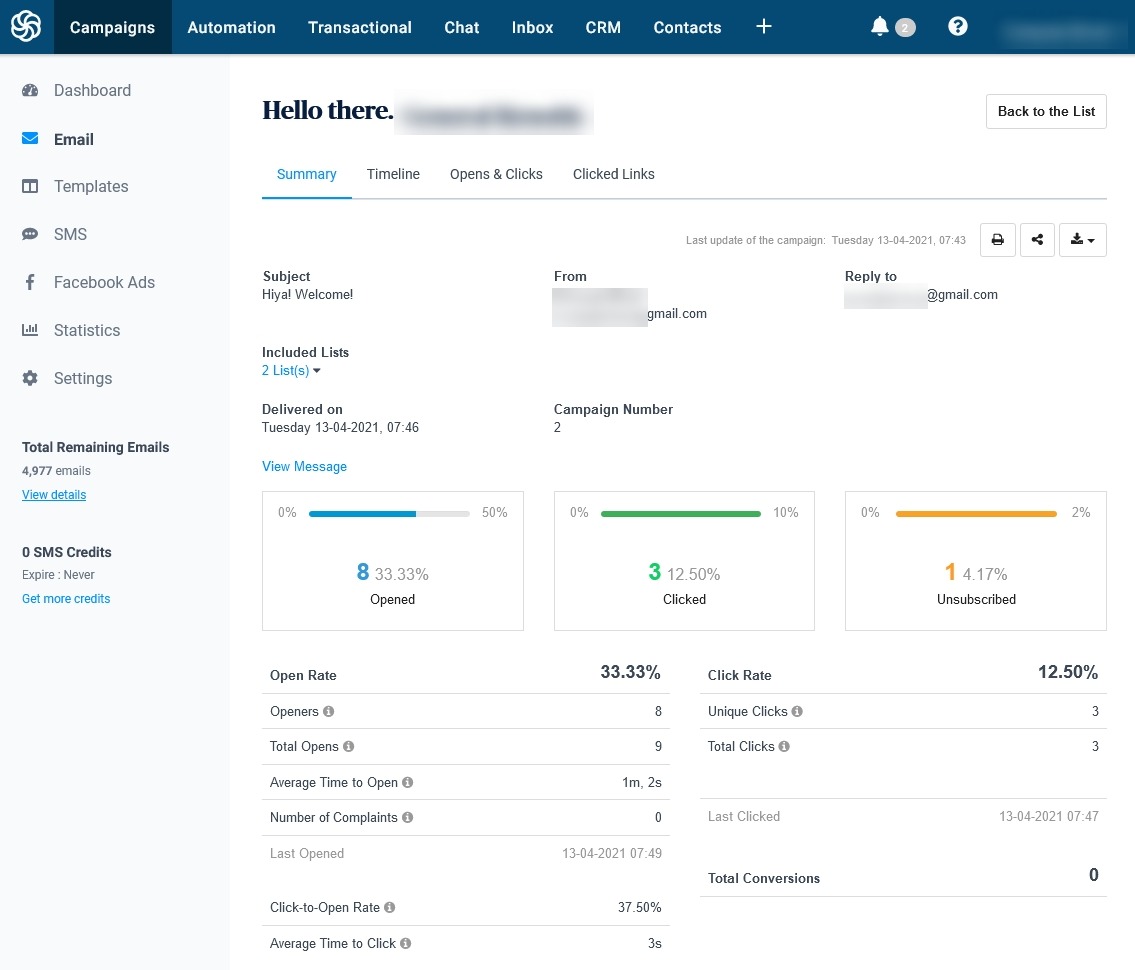
Analytics are so important in email marketing. Statistics show what content is working, and what is not. It tells you which designs people prefer, and which they don’t respond well to. Numbers tell the story of your email marketing, and who’s buying your stuff.
Sendinblue provides a simple built-in analytics dashboard that can give users an at-a-glance overview picture of what’s going on. The statistics can tell you how many emails were sent, how many people opened them, or clicked through with the links in them. It’ll also tell how many people unsubscribed, or engaged with the emails by replying to you.
It’s not a lot, but if you pay for the Premium plan, you can access more detailed analysis.
The more detailed reports for individual email campaigns are the real goldmine of Sendinblue. You can get timelines and stats for opened emails, conversions, clicks, time-to-click, and more. You can sort the stats by which lists your email contacts are on, and you can even see which links earned more click-through.
That is an important deal because you can see which recipients opened your emails, and clicked on which links. From there, you can sort subscribers however you like based on the information you have about each user.
However, if you want to have more advanced stats for free, you can integrate Sendinblue campaigns with Google analytics. Not everyone prefers Google Analytics these days, but it is still a good free option.
7. Additional features
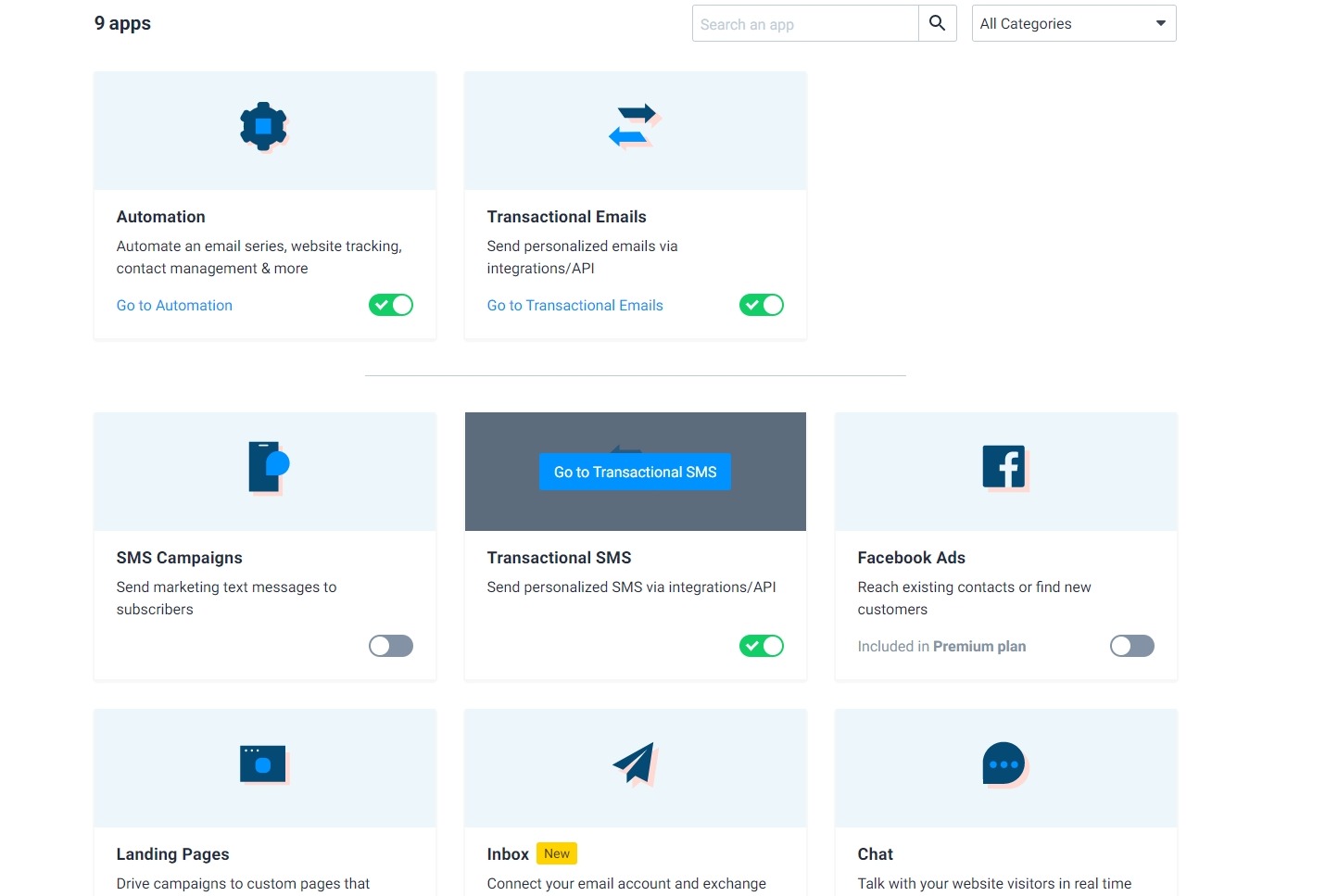
You’ll find all of the additional features in the Apps page. Most of these are free for anyone to use, even users on the limited free plan. The apps include some features like SMS campaigns and landing pages and are separated. (And remember, you still have to pay an extra fee for the landing pages).
Other extra features have the Inbox to read replies to the email campaigns you send. Then there are extra apps for live chat (to go on your website), Facebook ads, and customer relations management (CRM) software to track the relationships with customers.
You can also publish your email campaigns via SMS. If you think your customers must see your latest deals in text messages, this is the feature for you.
You can also share email campaigns via social media. However, I couldn’t find a way to share the campaign when you send it out to the mailing list. You have to manually click through a menu of the campaign you sent and then share it via social media. Well, that’s an extra step I don’t think is necessary.
Sendinblue’s deliverability review
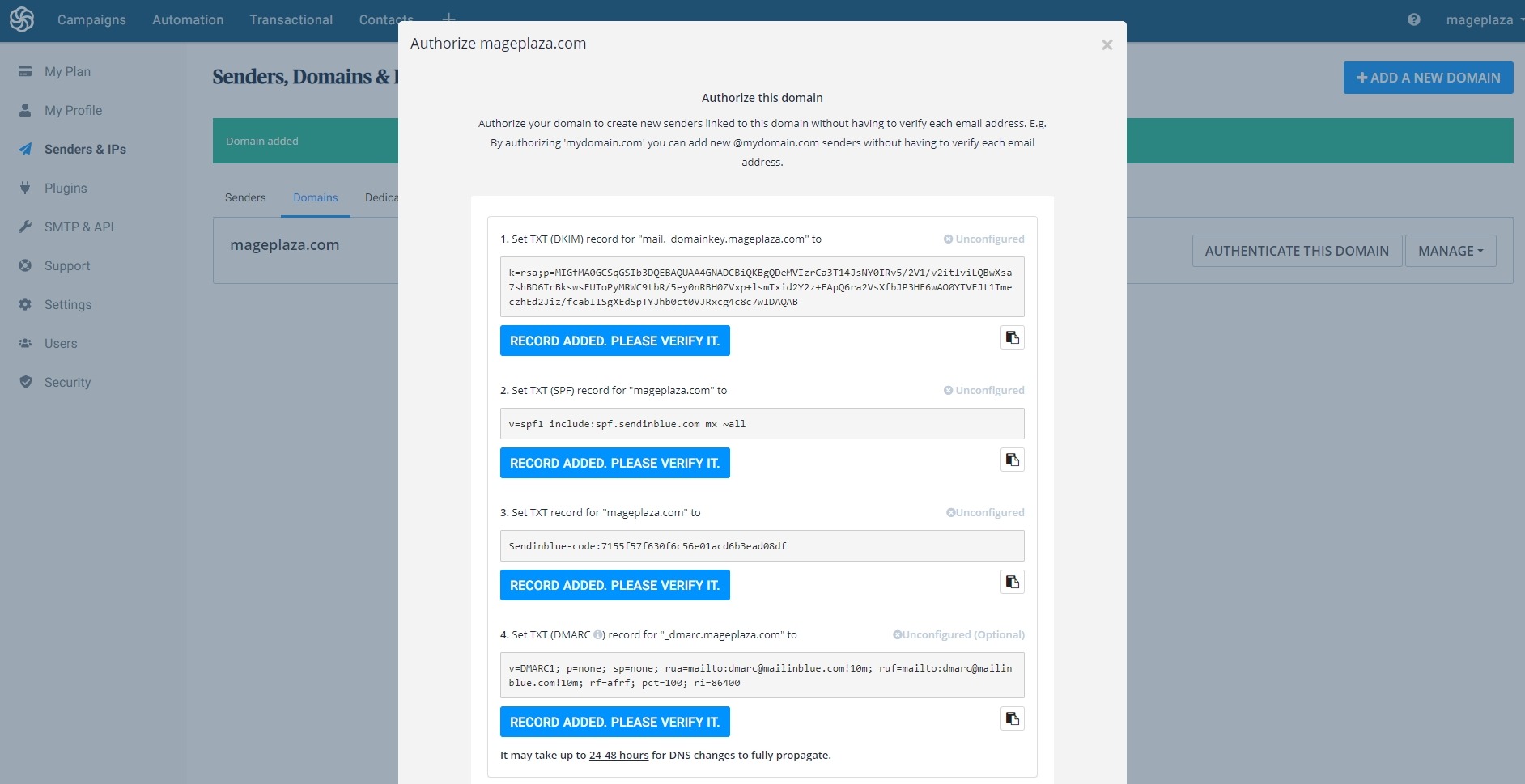
Email marketing platforms are understandably wary of spam and harmful email, so they should have some features designed to keep your emails from getting marked as spam. There are certain steps that need to be taken by your email marketing service to protect your campaigns.
Sendinblue has DKIM authentication and a simple guide about how to set it up. It is a means of protecting your emails by transiting via encryption. This means that when users receive emails from your domain, they can trust the emails are really from you.
Sendinblue also has a strong anti-spam policy, using manual verification for all new users and their accounts before they can start sending any email. Many users reviewed that this process is inconvenient so Sendinblue did improve it so users could send test emails more easily.

The downside: I tried to import a list of junk email addresses and added them to my contacts list. However, Sendinblue didn’t have a warning to prevent these bad addresses from being uploaded like many other email marketing platforms. Moreover, when I send a test email, Gmail immediately warns me of a spam threat from my account, which I never came across sending a test email with AVADA Email Marketing.
On a positive note, Sendinblue offers dedicated IP addresses to be purchased separately. Having a dedicated Ip address for your emails can help establish trust in the eyes of the email service provider. It’s best to have your own IP address and won’t be mistaken as an IP address of a spammer.
Overall, Sendinblue is still a trustworthy email marketing software for deliverability. Your emails should go where they’re supposed to, but your emails will be delivered without any trouble. There is room for improvement, but not much to worry about as an email marketer.
Sendinblue email marketing pricing plans
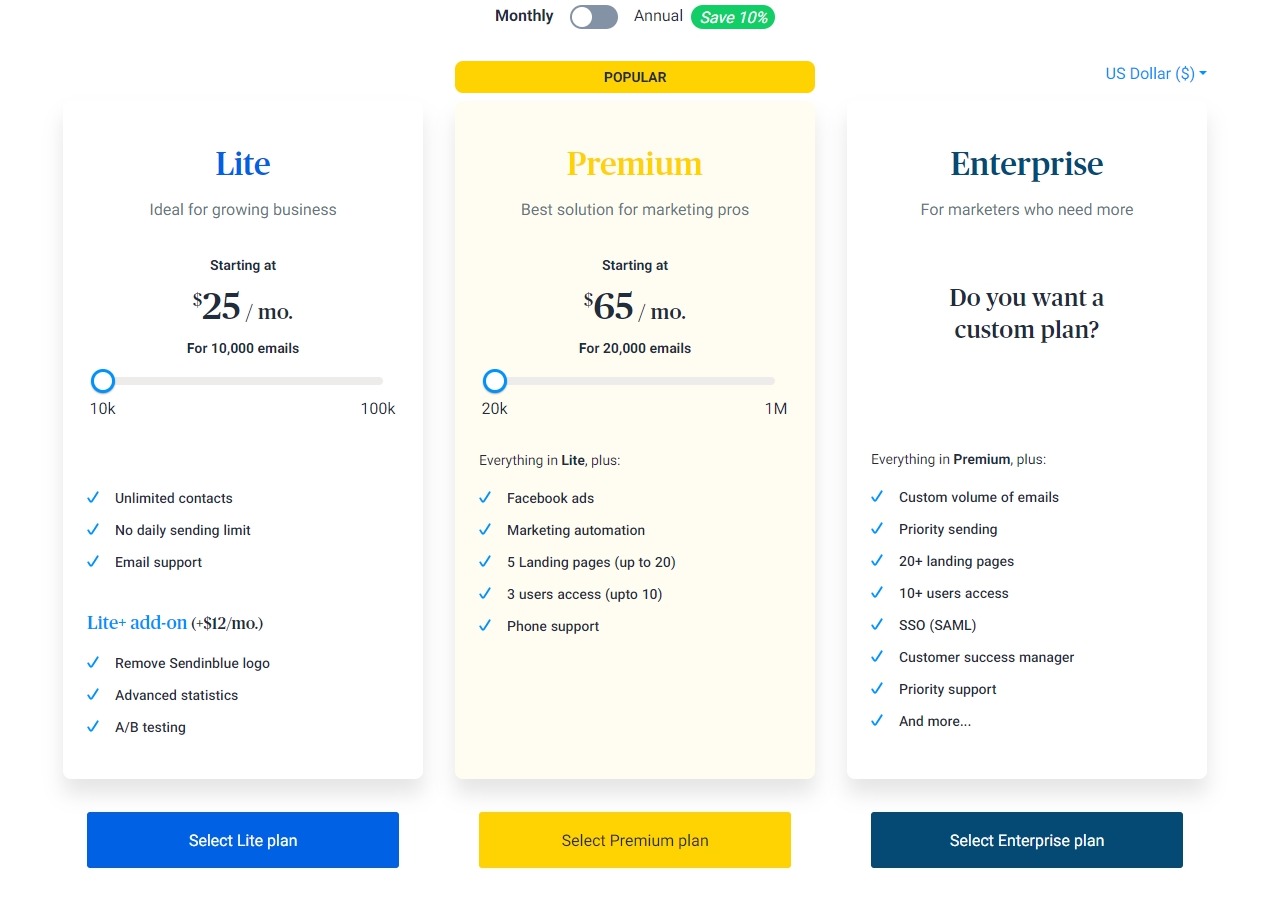
Sendinblue isn’t the cheapest email marketing software on the market, but its pricing is still competitive. The free plan is a good deal if you have few customers. 300 emails per day with a little Sendinblue logo at the bottom and a few limitations is a good starting point for an email marketer.
On the Lite plan, users can send 10,000 -100,000 emails per month, depending on the cost. The Lite plan starts at $25 a month and will remove the daily sending limit and let you use A/B testing as well as more advanced statistics.
The Premium plan starts at $65 per month and lets you send from 20,000 to 1 million emails per month. You will get access to landing pages, email automation, and multiple accounts to have a team managing your email marketing effort.
If you want to send SMS messages, it is a pay-as-you-go deal. Sending 100 text messages in the US is $1.34, 200 is $2.68, like that. Other countries will have different rates for SMSs.
All in all, Sendinblue’s pricing plans are affordable. However, there is no money-back guarantee, except when users encounter a technical issue. So you should use the free trial and try out before committing. You can pay the paid plan via major credit cards and Paypal.
Sendinblue support
There are two ways to contact Sendinblue support. You can use a contact form (located in the Contact page and in a popup of the Help Center page) to email a ticket. If you are in the Premium plan, you can call the phone support number.
The email support already received great reviews. It is available 24/7, and you can get responses within about 5 hours. There is an actual support team behind every response email and they all sound polite as well as helpful.
Sendinblue comparison
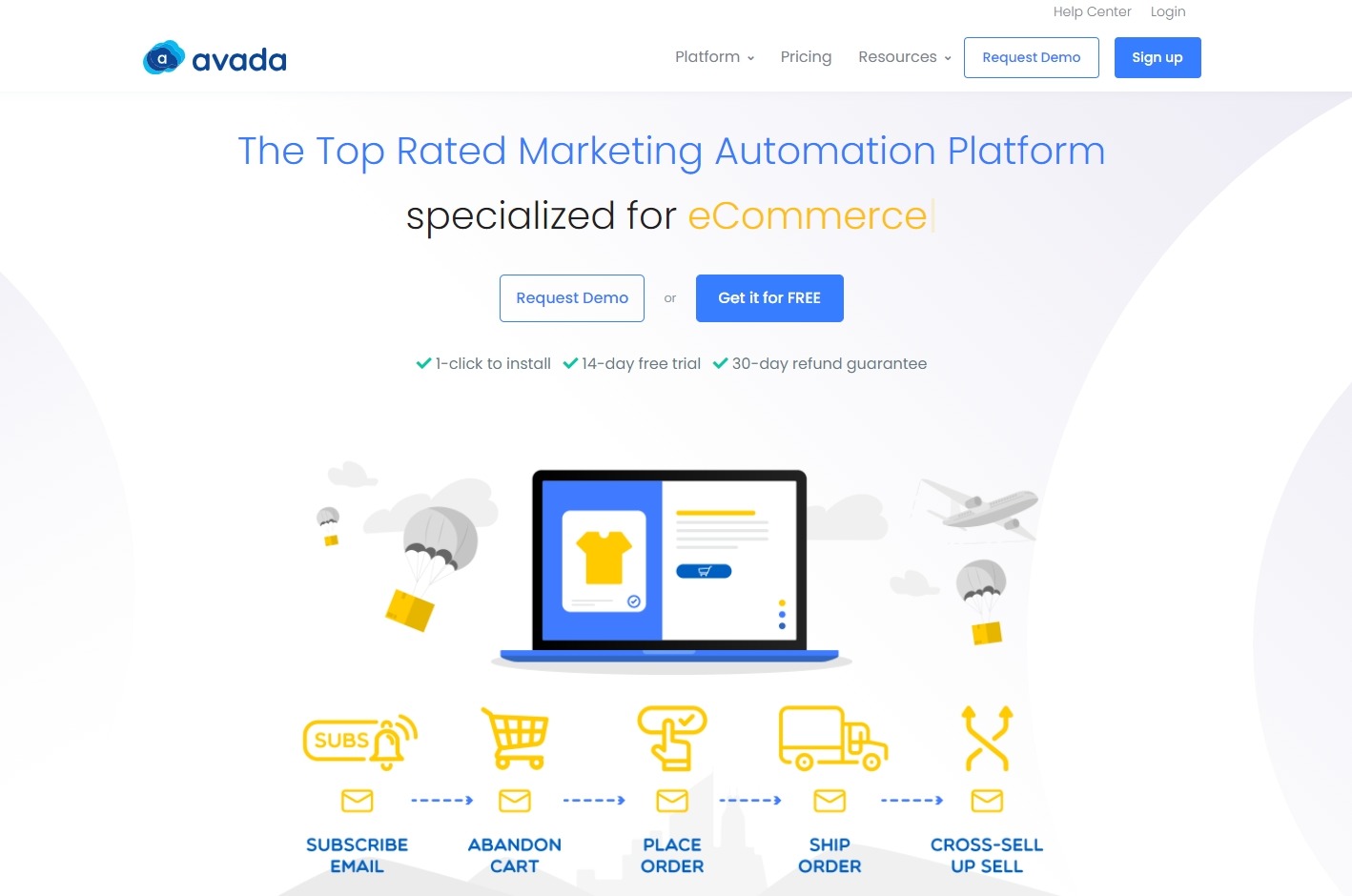
Lastly, I want to compare Sendinblue features with our own proud app - AVADA Email Marketing. I will go through the features in key points only, so if you want to learn more, make sure to check out AVADA Email Marketing; we also have a free plan to start using.
| Sendinblue email marketing | AVADA Email Marketing | |
|---|---|---|
| Free plan | Unlimited contacts, 300 emails per day | 1,000 contacts, 15,000 emails per month |
| Email templates | 65 templates in many categories | 18 modern newsletter templates |
| Email automation | 16 automation workflows | 28 automation workflows |
| Pricing plans | Starts at $25/month for 10,000 emails | Starts at $9/month for unlimited emails |
| Landing page | Available | Not available |
| SMS marketing | $0.011 for 1 SMS in the US | $0.015 for 1 SMS in the US |
| List management | List segmentation, importation, suppression, and advanced search | List segmentation, importation, suppression, and taggings |
| Additional features | Ads, live chat, and CRM | Form popups, combination of SMS and emails, photo reviews |
As you can see, the comparison shows that Sendinblue and AVADA Email Marketing are pretty neck to neck in features. Each has their own charms with features that can surpass the competitor. However, I would like to point out that AVADA Email Marketing has a more accessible premium plan and let users send unlimited emails.
Sendinblue email marketing review conclusion
As a conclusion, let’s look at the pros and cons of Sendinblue email marketing platform:
-
Pros: Affordable plans, Effective email automation, Landing page editor, Good deliverability, and SMS marketing tool
-
Cons: Free plan sending limit, Limited integrations, Not updated templates
So, who should be the user of the Sendinblue email marketing service? Suppose you are an eCommerce marketer looking for a sophisticated email tool at a reasonable price and want to start sending trigger-based campaigns. In that case, Sendinblue is a good option despite the cons. However, if you want to have many different users, you will need to sign up for a costly Premium plan, so consider that.
Is Sendinblue the email marketing platform you are looking for? Or perhaps you want to try AVADA Email Marketing instead? Give me your answer in the comments below!
New Posts






